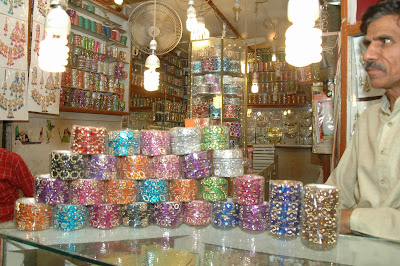Gumti bazaar of the walled city has an unique identity due to its historic and cultural importance. It is one of the oldest markets of the walled city of Lahore. However, mere historical facts are unable to answer questions like “when was this bazaar established and by whom and why was it named so?”,
It is said that it was established during the Moghal Era and by the time it established as big market.
Located in the centre of walled city of Lahore, Gumti bazaar is the centre of attraction for different reasons. This market is famous for Meena-kaari, Gota Kinaari, clothes, leather-items, wooden fabrics and artificial jewelry.
Beautiful pieces of artificial jewelry are available here within the range of Rs 500 to Rs 5000!
Gumti bazaar is located in the centre of Walled city of Lahore, so, one can enter into this market from different directions. Entering from Roshnai Gate or Bhaati gate and passing through Paani-Wala Talaab or from the direction of Lohari gate, you can reach this place by passing through Lungey Mandi.
Entering the market from Paani-wala Talaab, Ice-cream shops welcome you. As you move on you will see the leather goods shops on both sides. Keep on moving till you reach Chowk Gumti Bazaar. The bazaar is divided into two parts. Moving straight will take you towards Rung Mehal, another famous market. But look at the left side and you will see the true colors of Gumti bazaar. The lane is a bit narrow here, but glittered and bright due to colorful lighting.
Here, you can buy glass bangles, artificial jewelry, wedding dresses – basically a shopper’s paradise for the ladies. Specially, women prefer to do their pre-wedding shopping here. The very next bazaars are the Sooha bazaar and the Awaami
Before partition, Gumti bazaar was an area mostly populated by Hindus. The residental areas around Gumti bazaar are known as Galli Kali Maata, Koocha Beli Ram, Koocha Harjis Roy and Koocha Hanuman. There was only one Muslim family who used to live in Koocha Hanuman before partition. It was the residence of Molana Salah-uddin Ahmed, a writer and editor of the literary journal “Adabi Dunya”.
Rehana Bano, an old resident of Gumti bazaar says “Before partition, Hindus used to live here and I was living here with my grandfather during that period. I still remember that I was the only Muslim girl in that particular area. Hindu and Sikh children used to play in our yard, because it was quite wide and open. During games, I was also asked to swear by Kali Maata, and I did it many times”
Besides that, Gumti bazaar has also remained home of several important personalities. Indian film actor Om Parkash was born in Koocha Beli Ram and spent his childhood in the narrow streets of Gumti bazaar.
Gumti Bazaar is also famous for its painters. Prestigious painter Abdur Rehman Chughtai was one of them. He started his career as a wood pattern maker here. Then moved to Mayo School of Arts (Now National College of Arts) and carved his name in the history of colors and arts. Painters Master Ameer Bux and Meeraan Bux also belonged to the Chughtai family. They used to live in Koocha MusawwiraaN of Gumti bazaar. Later Master Ameer Bux was appointed as the head master of Municipal Technical College, Amritsar and Meeraan Bux joined Mayo School of Arts. Delhi’s Rashtrapati Bhawan (President’s House) was also designed by Meeraan Bux. Famous Sikh artist Naqaash Lahora Singh was also a resident of Gumti bazaar. His paintings are displayed in Patiala Museum.
As Gumti bazaar was a Hindu populated area, there were several Temples and Shivala buildings located here. Shivala Pandit Radha Kishan was known for its beautiful architecture. It was located near Syed Mitha Bazaar. Kali Maata temple was also another well known place of worship nearby. The street around this area is still called as Kali Mata Street. There was also a temple between Sooha bazaar and Gumti bazaar named as Krishna temple. Krishna temple was well-known for its beautiful and eye-catching architecture, which was known as ‘Sundar Mandir’ (Beautiful temple). As time passed, things changed, Hindu and Sikh residents left the area before and after the partition and now these temples don’t exist anymore, and one has put on a lot of effort to locate them.
It is really sad that most of the old buildings including temples and Havelis have been demolished and commercial plazas have replaced them.
Gumti bazaar is one of the typical Lahori bazaars, bursting with colors and lights.
Here are a few images of Gumti Bazaar.
Photos by: Afzal Abbas
























